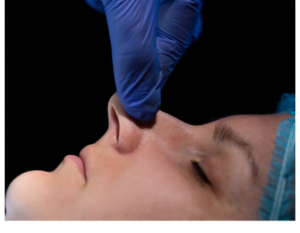While some people don’t even realize they have a deviated septum, those that do can experience severe symptoms. If you’re struggling to breathe and sleep normally because of a deviated septum, know that there are treatment options.
But is rhinoplasty in West Hills, CA one of them? Keep reading to find out what procedure can correct your deviated septum and help you breathe normally again.
Understanding a Deviated Septum
In between the two nostrils are a narrow piece of cartilage, tissue, and bone. When this wall leans to one side (or both), it deviates the septum. A deviated septum is commonly the result of a congenital defect, injury, or aging. No matter the cause, symptoms range from asymptomatic to extremely problematic. Many individuals with a deviated septum develop symptoms that progress as they get older, from upper respiratory infections and allergies.
Severe signs of a deviated septum include chronic sinus infections, difficulty breathing and sleeping, snoring, and nasal obstruction. When a deviated septum starts affecting a one’s quality of life, it’s time to look for a solution that straightens the structure and opens the nasal passageways.
The Role of Rhinoplasty in Deviated Septum
Put simply, rhinoplasty is a cosmetic nose surgery that does not repair a deviated septum. Instead, it revises the nose’s appearance, which occasionally includes repositioning cartilage, shaving the nasal bridge, or augmenting the tip. Individuals seeking to change the way their nose looks and to correct internal abnormalities of its structure like a deviated septum often require another procedure called septoplasty, in addition to rhinoplasty.
Rhinoplasty is a cosmetic surgery that can also be used to widen nostrils and nasal passageways for breathing, the procedure focuses on the nose’s outer aesthetics and features. Septoplasty, on the other hand, addresses the internal defects that cause physical discomfort, medical problems and breathing impairments; the procedure is often medically necessary.
The Right Procedure for a Deviated Septum
As mentioned above, septoplasty repairs a deviated septum, and other nasal defects and abnormalities. The minor surgery is generally less complex and intensive than rhinoplasty because there’s no trauma to the external parts of the face. The plastic surgeon creates incisions inside the nostrils to fix the septum. Dissolvable sutures and an internal splint are applied to the nose at the end of the procedure. The entire process typically takes less than 90 minutes for a board-certified septoplasty specialist to perform in an outpatient center.
Septoplasty and Rhinoplasty Combination
A deviated septum rarely causes physical changes to the nose’s exterior. Still, it’s not uncommon for septoplasty patients to want cosmetic alterations to address external features of their nose that they find undesirable. Fortunately, septorhinoplasty, a combination of septoplasty and rhinoplasty makes it possible to address both concerns simultaneously.
Post-operative Care and Recovery

The recovery process for septorhinoplasty patients is a bit different. The nose must heal internally and externally. Some discomfort is common the first few days after surgery. Common side effects include a stuffy nose, difficulty breathing, a mild headache, and minor bleeding for the first 2-3 days. Patients normally return to work within two weeks but should avoid strenuous activities for the next several weeks to months, depending on their post-operative care plan.
Risks and Complications
Septoplasty is a minor surgical procedure that comes with complication risks that include hyposmia (limited ability to smell) and infection, occurring in 5.4% and 4.2% of patients, respectively. Hyposmia is temporary and typically doesn’t last more than six months, and infections are preventable with proper post-op care and hygiene. Other potential risks include excessive bleeding (4.1%) and septal perforation (2.6%). While these are more serious, an experienced rhinoplasty surgeon takes the necessary precautions to avoid accidental cuts or tears.
Septoplasty Success Rates and Patient Satisfaction
Septoplasty has an extremely high success rate, and most patients are satisfied with the outcome. A 2013 study showed a significant drop in patient NOSE scores (a nasal obstruction assessment scale) after septoplasty, with average scores dropping from 76 to 15. 85 percent of septoplasty patients also reported significant improvements in breathing capacity, with a 63 percent success rate. Patients with more severe symptoms tend to benefit the most from the procedure.
Making the Decision
Even though a septoplasty is a minor, yet very effective procedure, it’s still surgery. Candidates should take time to consider the potential risks, their medical history, and current symptoms and benefits. Septoplasty is ideal for individuals with severe deviated septum symptoms (i.e., chronic sinus infections and impaired breathing capabilities). In some cases, those experiencing milder symptoms are better candidates for alternative, less invasive procedures.
Patients who decide to move forward with a septoplasty should also consider the possibility of combining it with a rhinoplasty in West Hills, CA. Combining both procedures does make surgery more complex and lengthens the recovery time, however, a septorhinoplasty can address both functional and cosmetic concerns with one procedure.
A certified ENT surgeon can help patients make the right decision. They can diagnose a deviated septum and suggest whether a surgical or nonsurgical approach is best. And if patients have cosmetic concerns, the surgeon can also create a personalized approach to help them achieve their desired look.
Conclusion
Rhinoplasty addresses the nose’s shape and appearance, but it doesn’t correct a deviated septum. There are treatments available for those experiencing severe symptoms, or unhappy with their nasal features such a septoplasty or septorhinoplasty in West Hills, CA respectively. Alternative procedures range from minimally invasive balloon sinuplasty and Functional Endoscopic Sinus Surgery (FESS).
To learn more about treatments for a deviated septum in West Hills, contact an ENT specialist to discuss your symptoms and goals. They can evaluate your deviated septum and help you determine the best treatment plan.

